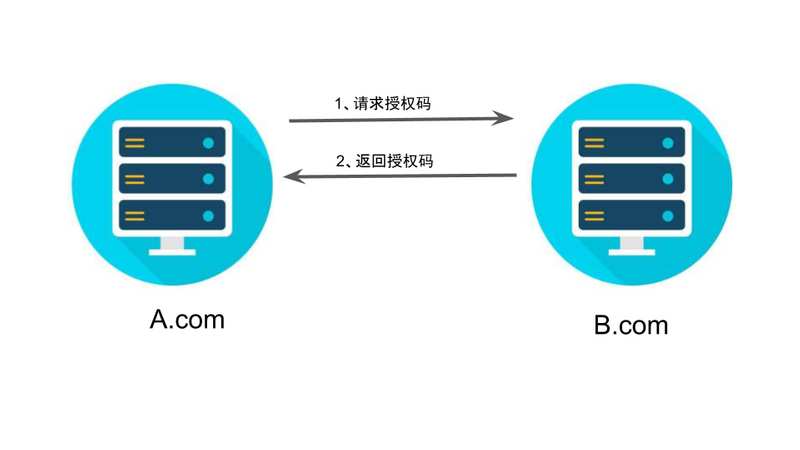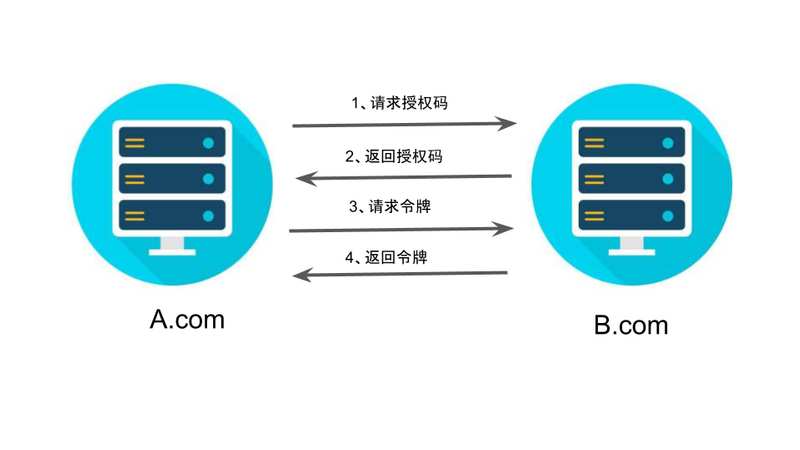oauth2.0授权码模式详解
oauth2.0授权码模式
欢迎关注博主公众号「Java大师」, 专注于分享Java领域干货文章http://www.javaman.cn/sb2/oauth-code
授权码(authorization code)方式,指的是第三方应用先申请一个授权码,然后再用该码获取令牌。
这种方式是最常用的流程,安全性也最高,它适用于那些有后端的 Web 应用。授权码通过前端传送,令牌则是储存在后端,而且所有与资源服务器的通信都在后端完成。这样的前后端分离,可以避免令牌泄漏。
1、授权码模式流程
第一步,A 网站提供一个链接,用户点击后就会跳转到 B 网站,授权用户数据给 A 网站使用。下面就是 A 网站跳转 B 网站的一个示意链接。
https://b.com/oauth/authorize? response_type=code& client_id=CLIENT_ID& redirect_uri=CALLBACK_URL& scope=read
上面 URL 中,response_type参数表示要求返回授权码(code),client_id参数让 B 知道是谁在请求,redirect_uri参数是 B 接受或拒绝请求后的跳转网址,scope参数表示要求的授权范围(这里是只读)。
第二步,用户跳转后,B 网站会要求用户登录,然后询问是否同意给予 A 网站授权。用户表示同意,这时 B 网站就会跳回redirect_uri参数指定的网址。跳转时,会传回一个授权码,就像下面这样。
https://a.com/callback?code=AUTHORIZATION_CODE
上面 URL 中,code参数就是授权码。
第三步,A 网站拿到授权码以后,就可以在后端,向 B 网站请求令牌。
https://b.com/oauth/token? client_id=CLIENT_ID& client_secret=CLIENT_SECRET& grant_type=authorization_code& code=AUTHORIZATION_CODE& redirect_uri=CALLBACK_URL
上面 URL 中,client_id参数和client_secret参数用来让 B 确认 A 的身份(client_secret参数是保密的,因此只能在后端发请求),grant_type参数的值是AUTHORIZATION_CODE,表示采用的授权方式是授权码,code参数是上一步拿到的授权码,redirect_uri参数是令牌颁发后的回调网址。
第四步,B 网站收到请求以后,就会颁发令牌。具体做法是向redirect_uri指定的网址,发送一段 JSON 数据。
{ "access_token":"ACCESS_TOKEN", "token_type":"bearer", "expires_in":2592000, "refresh_token":"REFRESH_TOKEN", "scope":"read", "uid":100101, "info":{...} }
上面 JSON 数据中,access_token字段就是令牌,A 网站在后端拿到了。
2、授权码模式实现代码
2.1 创建pom.xml
<project xmlns="http://maven.apache.org/POM/4.0.0" xmlns:xsi="http://www.w3.org/2001/XMLSchema-instance"
xsi:schemaLocation="http://maven.apache.org/POM/4.0.0 https://maven.apache.org/xsd/maven-4.0.0.xsd">
<modelVersion>4.0.0modelVersion>
<parent>
<groupId>org.springframework.bootgroupId>
<artifactId>spring-boot-starter-parentartifactId>
<version>2.2.6.RELEASEversion>
<relativePath/>
parent>
<groupId>com.dashigroupId>
<artifactId>springsecurity-oauthartifactId>
<version>0.0.1-SNAPSHOTversion>
<name>springsecurity-oauthname>
<description>Demo project for Spring Bootdescription>
<properties>
<java.version>1.8java.version>
<spring-cloud.version>Greenwich.SR5spring-cloud.version>
properties>
<dependencies>
<dependency>
<groupId>org.springframework.cloudgroupId>
<artifactId>spring-cloud-starter-oauth2artifactId>
dependency>
<dependency>
<groupId>org.springframework.cloudgroupId>
<artifactId>spring-cloud-starter-securityartifactId>
dependency>
<dependency>
<groupId>org.springframework.bootgroupId>
<artifactId>spring-boot-starterartifactId>
dependency>
<dependency>
<groupId>org.springframework.bootgroupId>
<artifactId>spring-boot-starter-webartifactId>
dependency>
<dependency>
<groupId>org.springframework.bootgroupId>
<artifactId>spring-boot-starter-testartifactId>
<scope>testscope>
dependency>
dependencies>
<build>
<plugins>
<plugin>
<groupId>org.springframework.bootgroupId>
<artifactId>spring-boot-maven-pluginartifactId>
plugin>
plugins>
build>
<dependencyManagement>
<dependencies>
<dependency>
<groupId>org.springframework.cloudgroupId>
<artifactId>spring-cloud-dependenciesartifactId>
<version>${spring-cloud.version}version>
<type>pomtype>
<scope>importscope>
dependency>
dependencies>
dependencyManagement>
project>
2.2 创建springsecurity配置文件
package com.dashi.springsecurityoauth.config;
import org.springframework.context.annotation.Bean;
import org.springframework.context.annotation.Configuration;
import org.springframework.security.config.annotation.web.builders.HttpSecurity;
import org.springframework.security.config.annotation.web.configuration.EnableWebSecurity;
import org.springframework.security.config.annotation.web.configuration.WebSecurityConfigurerAdapter;
import org.springframework.security.crypto.bcrypt.BCryptPasswordEncoder;
import org.springframework.security.crypto.password.PasswordEncoder;
@Configuration
@EnableWebSecurity
public class SecurityConfig extends WebSecurityConfigurerAdapter {
@Bean
public PasswordEncoder passwordEncoder(){
return new BCryptPasswordEncoder();
}
@Override
protected void configure(HttpSecurity http) throws Exception {
http.csrf().disable()
.authorizeRequests()
.antMatchers("/oauth/**","/login/**","/logout/**")
.permitAll()
.anyRequest()
.authenticated()
.and()
.formLogin()
.permitAll();
}
}
2.3 创建UserService实现UserDetailService接口
package com.dashi.springsecurityoauth.model;
import org.springframework.security.core.GrantedAuthority;
import org.springframework.security.core.userdetails.UserDetails;
import java.util.Collection;
import java.util.List;
public class User implements UserDetails {
private String username;
private String password;
private List<GrantedAuthority> authorities;
public User(String username, String password, List<GrantedAuthority> authorities) {
this.username = username;
this.password = password;
this.authorities = authorities;
}
@Override
public Collection<? extends GrantedAuthority> getAuthorities() {
return this.authorities;
}
@Override
public String getPassword() {
return this.password;
}
@Override
public String getUsername() {
return this.username;
}
@Override
public boolean isAccountNonExpired() {
return true;
}
@Override
public boolean isAccountNonLocked() {
return true;
}
@Override
public boolean isCredentialsNonExpired() {
return true;
}
@Override
public boolean isEnabled() {
return true;
}
}
2.4 创建认证服务
package com.dashi.springsecurityoauth.config;
import org.springframework.beans.factory.annotation.Autowired;
import org.springframework.context.annotation.Configuration;
import org.springframework.security.crypto.password.PasswordEncoder;
import org.springframework.security.oauth2.config.annotation.configurers.ClientDetailsServiceConfigurer;
import org.springframework.security.oauth2.config.annotation.web.configuration.AuthorizationServerConfigurerAdapter;
import org.springframework.security.oauth2.config.annotation.web.configuration.EnableAuthorizationServer;
@Configuration
@EnableAuthorizationServer
public class AuthorizationServerConfig extends AuthorizationServerConfigurerAdapter {
@Autowired
private PasswordEncoder passwordEncoder;
@Override
public void configure(ClientDetailsServiceConfigurer clients) throws Exception {
clients.inMemory()
.withClient("admin")
.secret(passwordEncoder.encode("654321"))
.accessTokenValiditySeconds(3600)
.redirectUris("http://www.baidu.com")
.scopes("all")
//配置grant_type,表示授权码授权
.authorizedGrantTypes("authorization_code");
}
}
2.5 创建资源服务
package com.dashi.springsecurityoauth.config;
import org.springframework.context.annotation.Configuration;
import org.springframework.security.config.annotation.web.builders.HttpSecurity;
import org.springframework.security.oauth2.config.annotation.web.configuration.EnableResourceServer;
import org.springframework.security.oauth2.config.annotation.web.configuration.ResourceServerConfigurerAdapter;
@Configuration
@EnableResourceServer
public class ResourceServerConfig extends ResourceServerConfigurerAdapter {
@Override
public void configure(HttpSecurity http) throws Exception {
http.authorizeRequests()
.anyRequest()
.authenticated()
.and()
.requestMatchers()
//以/user开头的地址根据token访问资源
.antMatchers("/user/**");
}
}
2.6启动服务访问地址
http://localhost:8080/oauth/authorize?response_type=code&client_id=admin&redirect_uri=http://www.baidu.com&scope=all
2.7上一步连接跳转到输入用户名和地址
2.8 点击允许受访问的资源,跳转到授权网站(http://www.baidu.com),获取授权码
参考文档:OAuth 2.0 的四种方式 - 阮一峰的网络日志 (ruanyifeng.com)









